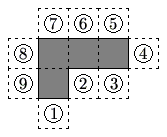2003 AMC 12A Problems/Problem 13
Problem
The polygon enclosed by the solid lines in the figure consists of 4 congruent squares joined edge-to-edge. One more congruent square is attatched to an edge at one of the nine positions indicated. How many of the nine resulting polygons can be folded to form a cube with one face missing?
![]()
Solution
Let the squares be labeled ![]() ,
, ![]() ,
, ![]() , and
, and ![]() .
.
When the polygon is folded, the "right" edge of square ![]() becomes adjacent to the "bottom edge" of square
becomes adjacent to the "bottom edge" of square ![]() , and the "bottom" edge of square
, and the "bottom" edge of square ![]() becomes adjacent to the "bottom" edge of square
becomes adjacent to the "bottom" edge of square ![]() .
.
So, any "new" square that is attatched to those edges will prevent the polygon from becoming a cube with one face missing.
Therefore, squares ![]() ,
, ![]() , and
, and ![]() will prevent the polygon from becoming a cube with one face missing.
will prevent the polygon from becoming a cube with one face missing.
Squares ![]() ,
, ![]() ,
, ![]() ,
, ![]() ,
, ![]() , and
, and ![]() will allow the polygon to become a cube with one face missing when folded.
will allow the polygon to become a cube with one face missing when folded.
Thus the answer is ![]() .
.










